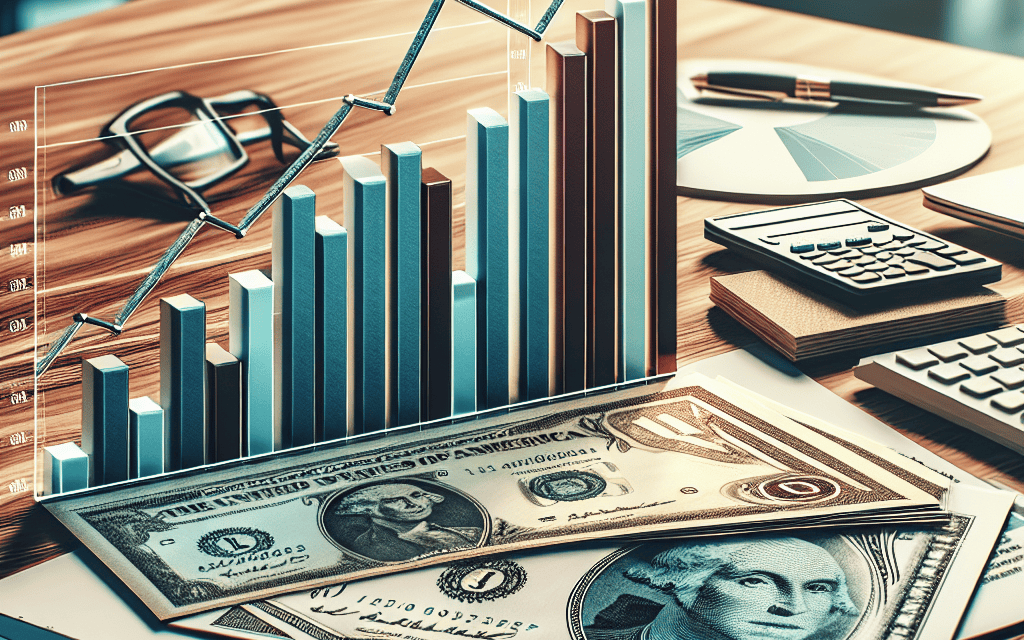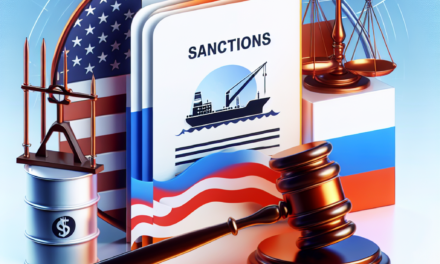“Rising Interest Costs: A 28-Year High Fuels Political Turbulence”
Introduction
In recent developments, the United States has witnessed a significant surge in its interest costs, reaching a 28-year peak. This escalation in borrowing expenses is stirring political uncertainty and raising concerns about the nation’s fiscal health. As interest rates climb, the cost of servicing the national debt has become a focal point of economic discourse, influencing policy decisions and budgetary priorities. The heightened financial burden poses challenges for lawmakers, potentially impacting government spending and investment in critical areas. This situation underscores the intricate balance between managing national debt and fostering economic growth, as policymakers navigate the complexities of fiscal responsibility amid evolving economic conditions.
Impact Of Rising US Interest Costs On The National Budget
The recent surge in U.S. interest costs has reached a 28-year peak, a development that is casting a long shadow over the national budget and heightening political uncertainty. As the federal government grapples with this financial burden, the implications for fiscal policy and economic stability are becoming increasingly pronounced. This rise in interest costs is primarily attributed to the combination of elevated national debt levels and the Federal Reserve’s monetary policy adjustments aimed at curbing inflation. Consequently, the government is now faced with the challenge of managing these costs while maintaining essential public services and programs.
To understand the impact of rising interest costs on the national budget, it is crucial to consider the broader economic context. Over the past few years, the U.S. has experienced significant fiscal expansion, driven by pandemic-related spending and infrastructure investments. While these measures were necessary to support the economy during turbulent times, they have also contributed to an increase in the national debt. As interest rates climb, the cost of servicing this debt rises, thereby consuming a larger portion of the federal budget. This situation is further exacerbated by the Federal Reserve’s efforts to combat inflation through interest rate hikes, which, while necessary to stabilize prices, inadvertently increase the government’s borrowing costs.
The ramifications of these rising interest costs are multifaceted. On one hand, they place additional pressure on the federal budget, potentially crowding out other critical expenditures. For instance, funds that could have been allocated to healthcare, education, or infrastructure may now be redirected to cover interest payments. This reallocation of resources can hinder the government’s ability to invest in long-term growth and development initiatives, thereby affecting the overall economic trajectory. Moreover, as interest costs consume a larger share of the budget, the government may face difficult decisions regarding spending cuts or tax increases, both of which carry significant political and economic implications.
In addition to budgetary constraints, the rise in interest costs also contributes to heightened political uncertainty. As policymakers navigate this complex financial landscape, debates over fiscal responsibility and budget priorities are likely to intensify. The challenge of balancing the need for fiscal discipline with the demands for public investment and social welfare programs is a contentious issue that could lead to political gridlock. Furthermore, as the 2024 elections approach, the discourse surrounding fiscal policy and national debt is expected to become a central theme, influencing both domestic and international perceptions of U.S. economic stability.
Despite these challenges, there are potential strategies that could mitigate the impact of rising interest costs on the national budget. For instance, implementing targeted fiscal reforms aimed at enhancing revenue generation and optimizing expenditure could help alleviate some of the financial pressures. Additionally, fostering economic growth through strategic investments in innovation and workforce development could increase the government’s revenue base, thereby offsetting some of the interest burden. However, these measures require careful planning and bipartisan cooperation, which may prove difficult in the current polarized political climate.
In conclusion, the rise in U.S. interest costs to a 28-year peak presents significant challenges for the national budget and contributes to an atmosphere of political uncertainty. As the government seeks to navigate this complex financial environment, the need for prudent fiscal management and strategic policy decisions becomes increasingly critical. The path forward will require a delicate balance between addressing immediate budgetary pressures and laying the groundwork for sustainable economic growth, a task that demands both political will and economic foresight.
Historical Comparison: US Interest Costs Over The Past 28 Years
Over the past 28 years, the trajectory of US interest costs has been a subject of considerable scrutiny, reflecting broader economic trends and fiscal policies. As of 2023, these costs have reached a 28-year peak, a development that has intensified political uncertainty and prompted a reevaluation of fiscal strategies. To understand the implications of this peak, it is essential to examine the historical context and the factors that have contributed to the current situation.
In the mid-1990s, the United States was navigating a period of economic expansion, characterized by robust growth and relatively low interest rates. During this time, interest costs were manageable, allowing the government to focus on other fiscal priorities. However, as the new millennium approached, the economic landscape began to shift. The early 2000s saw a series of economic challenges, including the bursting of the dot-com bubble and the aftermath of the September 11 attacks, which led to increased government borrowing and a subsequent rise in interest costs.
The financial crisis of 2008 marked a significant turning point. In response to the crisis, the Federal Reserve implemented a series of unconventional monetary policies, including near-zero interest rates and quantitative easing. These measures were designed to stimulate the economy but also resulted in a substantial increase in government debt. Consequently, while interest rates remained low, the sheer volume of debt began to push interest costs upward.
As the economy gradually recovered, interest rates started to rise, further exacerbating the burden of interest costs. The period from 2010 to 2020 was marked by a delicate balancing act, as policymakers sought to manage the growing debt while fostering economic growth. The COVID-19 pandemic in 2020 added another layer of complexity, necessitating unprecedented levels of government spending to support the economy. This spending, while necessary, further increased the national debt and set the stage for the current peak in interest costs.
In 2023, the convergence of several factors has led to the highest interest costs in nearly three decades. Rising interest rates, driven by efforts to combat inflation, have significantly increased the cost of servicing the national debt. At the same time, the accumulated debt from years of fiscal stimulus and emergency spending has reached levels that are difficult to sustain without substantial fiscal adjustments. This situation has heightened political uncertainty, as policymakers grapple with the challenge of balancing fiscal responsibility with the need to support economic growth.
The political implications of these rising interest costs are profound. On one hand, there is pressure to implement austerity measures to rein in the debt and reduce interest costs. On the other hand, there is a need to invest in critical areas such as infrastructure, education, and healthcare to ensure long-term economic stability. This tension has led to heated debates among policymakers, with differing views on the best path forward.
In conclusion, the peak in US interest costs in 2023 is a culmination of decades of economic and fiscal developments. As the nation navigates this challenging landscape, the decisions made today will have far-reaching implications for future generations. Understanding the historical context of these interest costs provides valuable insights into the complexities of fiscal policy and the importance of prudent economic management. As political uncertainty looms, the need for thoughtful and strategic decision-making has never been more critical.
Political Implications Of Increased US Interest Costs
The recent surge in U.S. interest costs, reaching a 28-year peak, has sparked significant political uncertainty, raising questions about the broader implications for the nation’s fiscal policy and economic stability. As interest rates climb, the cost of servicing the national debt has become a pressing concern for policymakers, who must now grapple with the challenge of balancing fiscal responsibility with the need to support economic growth. This situation is further complicated by the political landscape, where differing ideologies on government spending and taxation create a contentious environment for decision-making.
To understand the political implications of increased U.S. interest costs, it is essential to consider the broader economic context. The Federal Reserve’s monetary policy, aimed at curbing inflation, has led to higher interest rates, which in turn have increased the cost of borrowing for the federal government. As a result, a larger portion of the federal budget is now allocated to interest payments, leaving less room for discretionary spending on critical programs such as healthcare, education, and infrastructure. This shift in budgetary priorities has the potential to exacerbate existing political tensions, as lawmakers are forced to make difficult choices about where to allocate limited resources.
Moreover, the rising interest costs have intensified the debate over the national debt, which has been a contentious issue in American politics for decades. Some policymakers argue that the growing debt burden poses a significant threat to the country’s long-term economic health, necessitating immediate action to reduce deficits through spending cuts or tax increases. Others contend that the focus should be on fostering economic growth, which would naturally increase government revenues and help manage the debt over time. This ideological divide has made it challenging to reach a consensus on fiscal policy, contributing to the political uncertainty surrounding the issue.
In addition to domestic considerations, the increased interest costs have implications for the United States’ position on the global stage. As the world’s largest economy, the U.S. plays a critical role in international financial markets, and its fiscal policies can have far-reaching effects. Higher interest costs may lead to a stronger dollar, which could impact trade balances and complicate diplomatic relations with other countries. Furthermore, the perception of fiscal instability could undermine confidence in U.S. financial markets, potentially leading to increased volatility and reduced foreign investment.
The political uncertainty stemming from rising interest costs is further compounded by the upcoming election cycle, as candidates from both major parties seek to address voters’ concerns about the economy. The issue of fiscal responsibility is likely to be a central theme in campaign rhetoric, with candidates proposing various solutions to manage the national debt and interest costs. However, the polarized nature of American politics may make it difficult to implement meaningful reforms, as partisan divisions often hinder the ability to reach bipartisan agreements.
In conclusion, the peak in U.S. interest costs has significant political implications, both domestically and internationally. As policymakers navigate this complex landscape, they must balance the need for fiscal responsibility with the imperative to support economic growth and maintain global stability. The challenge lies in finding common ground amidst ideological differences, ensuring that the nation’s fiscal policies are sustainable and conducive to long-term prosperity. As the political discourse continues to evolve, the outcome will have lasting effects on the U.S. economy and its role in the world.
Strategies For Managing The US Debt Amid Rising Interest Costs

As the United States grapples with the highest interest costs in nearly three decades, the political landscape is becoming increasingly fraught with uncertainty. This financial strain, driven by a combination of rising interest rates and a burgeoning national debt, necessitates a strategic approach to managing the country’s fiscal responsibilities. The challenge is not only to address the immediate financial burden but also to implement long-term strategies that ensure economic stability and growth.
To begin with, understanding the root causes of this predicament is essential. The Federal Reserve’s recent interest rate hikes, aimed at curbing inflation, have inadvertently increased the cost of servicing the national debt. As interest rates climb, so too does the government’s expenditure on interest payments, which diverts funds from other critical areas such as infrastructure, education, and healthcare. This situation is further exacerbated by the sheer size of the national debt, which has ballooned to unprecedented levels due to years of deficit spending.
In light of these challenges, one potential strategy for managing the US debt is to prioritize fiscal discipline. This involves making difficult decisions about government spending and revenue generation. By carefully evaluating and potentially reducing discretionary spending, the government can reallocate resources to more pressing needs. Additionally, reforming entitlement programs, which constitute a significant portion of federal expenditures, could also contribute to long-term fiscal sustainability. However, such reforms are often politically contentious, requiring bipartisan cooperation and a willingness to compromise.
Another approach is to enhance revenue through tax reforms. By closing loopholes and ensuring that tax policies are equitable and efficient, the government can increase its revenue without necessarily raising tax rates. This could involve revisiting corporate tax structures, addressing offshore tax havens, and ensuring that high-income earners contribute their fair share. While tax reform can be a politically sensitive issue, it remains a crucial component of any comprehensive debt management strategy.
Moreover, fostering economic growth is a vital element in managing the national debt. A robust economy generates higher tax revenues, which can help offset the costs of debt servicing. To stimulate growth, the government can invest in areas that yield long-term economic benefits, such as technology, education, and infrastructure. By creating an environment conducive to innovation and productivity, the US can enhance its competitive edge in the global market, thereby boosting economic output and reducing the relative burden of the debt.
In addition to these domestic strategies, international cooperation can also play a role in managing the US debt. Engaging with global financial institutions and fostering strong economic ties with other nations can provide avenues for investment and trade that bolster the US economy. Furthermore, maintaining a stable geopolitical environment is crucial for ensuring that interest rates remain manageable and that the US dollar retains its status as the world’s reserve currency.
In conclusion, the rising interest costs on the US debt present a formidable challenge that requires a multifaceted approach. By implementing strategies that emphasize fiscal discipline, tax reform, economic growth, and international cooperation, the United States can navigate this period of political uncertainty and lay the groundwork for a more stable financial future. While the path forward may be fraught with political hurdles, the imperative to act is clear, as the consequences of inaction could have far-reaching implications for the nation’s economic well-being.
Economic Consequences Of High US Interest Costs On Global Markets
The recent surge in U.S. interest costs, reaching a 28-year peak, has sent ripples through global markets, raising concerns about the broader economic implications. As the world’s largest economy grapples with these heightened costs, the effects are being felt far beyond its borders, influencing financial markets, trade dynamics, and economic policies worldwide. This development comes at a time when political uncertainty in the United States is already a significant concern, further complicating the global economic landscape.
To understand the impact of rising U.S. interest costs, it is essential to consider the interconnected nature of global financial markets. The U.S. dollar, serving as the world’s primary reserve currency, plays a pivotal role in international trade and finance. Consequently, changes in U.S. interest rates can have far-reaching effects on global capital flows. As interest costs rise, borrowing becomes more expensive, not only for the U.S. government but also for businesses and consumers. This can lead to a tightening of financial conditions, which may dampen economic growth both domestically and internationally.
Moreover, higher U.S. interest rates tend to attract foreign capital, as investors seek better returns on their investments. This influx of capital can lead to an appreciation of the U.S. dollar, making American exports more expensive and imports cheaper. Such currency fluctuations can disrupt trade balances, affecting countries that rely heavily on exports to the United States. Emerging markets, in particular, may face increased pressure as their currencies depreciate against the dollar, leading to higher costs for servicing dollar-denominated debt.
In addition to these economic consequences, the political uncertainty surrounding U.S. fiscal policy adds another layer of complexity. As interest costs rise, the U.S. government faces mounting pressure to address its fiscal challenges. This situation is exacerbated by the political gridlock that often characterizes the U.S. legislative process, making it difficult to implement effective fiscal policies. The uncertainty surrounding potential policy changes can create volatility in financial markets, as investors react to shifting expectations about future economic conditions.
Furthermore, the global economy is still recovering from the disruptions caused by the COVID-19 pandemic, and the rise in U.S. interest costs could hinder this recovery. Many countries have already implemented accommodative monetary policies to support growth, and a tightening of financial conditions could undermine these efforts. Central banks around the world may be forced to reassess their policy stances, balancing the need to support economic recovery with the risks posed by rising inflation and financial instability.
In conclusion, the peak in U.S. interest costs presents significant challenges for global markets, with potential repercussions for trade, investment, and economic growth. The interconnectedness of the global economy means that developments in the United States can have wide-ranging effects, influencing economic policies and financial conditions worldwide. As political uncertainty continues to loom, it is crucial for policymakers to navigate these challenges carefully, ensuring that efforts to address fiscal issues do not inadvertently destabilize the global economy. The path forward will require coordinated international efforts to manage the economic consequences of high U.S. interest costs while fostering a stable and sustainable global economic environment.
The Role Of Federal Reserve Policies In US Interest Cost Trends
The recent surge in U.S. interest costs, reaching a 28-year peak, has become a focal point of economic discourse, drawing attention to the intricate role of Federal Reserve policies in shaping these trends. As the Federal Reserve navigates the complex landscape of monetary policy, its decisions have profound implications for the nation’s fiscal health and political stability. Understanding the interplay between Federal Reserve actions and interest cost trends is crucial for comprehending the broader economic environment.
To begin with, the Federal Reserve’s primary tool for influencing interest rates is the federal funds rate, which serves as a benchmark for short-term interest rates across the economy. By adjusting this rate, the Federal Reserve aims to either stimulate economic growth or curb inflation. In recent years, the Federal Reserve has faced the challenging task of balancing these objectives amid fluctuating economic conditions. Following the financial crisis of 2008, the Federal Reserve adopted an accommodative monetary policy stance, maintaining historically low interest rates to spur economic recovery. However, as the economy gradually regained its footing, the Federal Reserve began to incrementally raise rates to prevent overheating and control inflationary pressures.
This shift in monetary policy has had a direct impact on U.S. interest costs. As the Federal Reserve increased the federal funds rate, borrowing costs for the government rose correspondingly. Consequently, the interest payments on the national debt have surged, contributing to the current peak in interest costs. This development underscores the delicate balance the Federal Reserve must strike between fostering economic growth and managing the nation’s fiscal obligations.
Moreover, the Federal Reserve’s policies have broader implications for political uncertainty. Rising interest costs place additional strain on the federal budget, potentially crowding out other essential expenditures. This situation can lead to contentious debates among policymakers regarding budget priorities and fiscal responsibility. As interest payments consume a larger share of the budget, the pressure to address the growing national debt intensifies, often resulting in political gridlock and uncertainty.
In addition to domestic considerations, Federal Reserve policies also influence global financial markets. Changes in U.S. interest rates can trigger capital flows across borders, affecting exchange rates and economic conditions in other countries. This interconnectedness means that Federal Reserve decisions reverberate beyond U.S. borders, adding another layer of complexity to the political landscape. International stakeholders closely monitor these developments, as shifts in U.S. monetary policy can have far-reaching consequences for global economic stability.
Furthermore, the Federal Reserve’s communication strategy plays a pivotal role in shaping market expectations and mitigating uncertainty. By providing clear guidance on its policy intentions, the Federal Reserve aims to reduce market volatility and foster confidence among investors and policymakers. However, the inherent unpredictability of economic conditions means that even well-communicated policies can lead to unforeseen outcomes, further complicating the political environment.
In conclusion, the recent peak in U.S. interest costs highlights the significant influence of Federal Reserve policies on economic and political dynamics. As the Federal Reserve continues to navigate the challenges of monetary policy, its decisions will remain a critical factor in shaping interest cost trends and the broader economic landscape. Understanding this intricate relationship is essential for policymakers, investors, and citizens alike as they grapple with the implications of rising interest costs and the accompanying political uncertainty.
Future Projections: US Interest Costs And Political Stability
The recent surge in U.S. interest costs, reaching a 28-year peak, has become a focal point of concern for economists and policymakers alike. This development not only underscores the financial challenges facing the nation but also amplifies the political uncertainty that has been simmering beneath the surface. As interest costs climb, the implications for future fiscal policy and political stability become increasingly significant.
To understand the gravity of the situation, it is essential to consider the factors contributing to this rise in interest costs. Primarily, the Federal Reserve’s monetary policy, aimed at curbing inflation, has led to higher interest rates. While this approach is intended to stabilize the economy, it inadvertently increases the cost of servicing the national debt. Consequently, the federal government finds itself allocating a larger portion of its budget to interest payments, thereby constraining its ability to fund other critical programs and initiatives.
Moreover, the burgeoning interest costs exacerbate the already contentious political landscape. As policymakers grapple with budgetary constraints, debates over spending priorities become more pronounced. This fiscal strain often leads to partisan disagreements, with each side advocating for different solutions to manage the growing debt burden. The heightened political tension can result in legislative gridlock, making it challenging to implement effective economic policies.
In addition to domestic political ramifications, the rising interest costs have international implications. The U.S. dollar’s status as the world’s reserve currency means that fluctuations in U.S. fiscal policy reverberate globally. As interest costs rise, foreign investors may reassess their confidence in U.S. Treasury securities, potentially leading to shifts in global financial markets. This scenario could further complicate the U.S. government’s efforts to manage its debt, as changes in investor sentiment might influence borrowing costs and capital flows.
Looking ahead, the trajectory of U.S. interest costs will likely depend on several key factors. The Federal Reserve’s future monetary policy decisions will play a crucial role in determining interest rate trends. Should inflationary pressures persist, the Fed may continue to raise rates, thereby maintaining upward pressure on interest costs. Conversely, if inflation subsides, there may be room for rate stabilization or reduction, which could alleviate some of the fiscal pressure.
Furthermore, the political landscape will significantly influence how the U.S. navigates its interest cost challenges. Bipartisan cooperation will be essential to develop sustainable fiscal policies that address the root causes of rising debt and interest expenses. However, achieving such cooperation may prove difficult in a polarized political environment, where consensus is often elusive.
In conclusion, the peak in U.S. interest costs represents a critical juncture for both economic policy and political stability. As the nation grapples with these challenges, the interplay between fiscal decisions and political dynamics will shape the future trajectory of interest costs. Policymakers must carefully balance the need for economic stability with the imperative of maintaining political cohesion. By doing so, they can work towards a more sustainable fiscal future, mitigating the risks associated with high interest costs and fostering a more stable political environment.
Q&A
1. **What is the current peak of US interest costs?**
– US interest costs have reached their highest level in 28 years, reflecting increased borrowing expenses due to rising interest rates and national debt.
2. **Why have US interest costs reached a 28-year peak?**
– The peak is primarily due to a combination of rising interest rates set by the Federal Reserve to combat inflation and the growing national debt, which increases the amount the government must pay in interest.
3. **How does the increase in interest costs affect the US budget?**
– Higher interest costs consume a larger portion of the federal budget, potentially leading to reduced funding for other government programs and services.
4. **What are the political implications of rising US interest costs?**
– The increase in interest costs heightens political uncertainty as lawmakers may face pressure to address the growing debt and budget deficits, potentially leading to contentious debates over spending cuts or tax increases.
5. **How might rising interest costs impact future US fiscal policy?**
– Rising interest costs could force policymakers to prioritize debt reduction and fiscal responsibility, possibly resulting in austerity measures or reforms to entitlement programs.
6. **What role does the Federal Reserve play in the current interest cost situation?**
– The Federal Reserve influences interest costs through its monetary policy decisions, particularly by setting benchmark interest rates that affect borrowing costs across the economy.
7. **What are potential solutions to manage rising US interest costs?**
– Solutions may include implementing fiscal reforms to reduce the deficit, restructuring existing debt, or enacting policies to stimulate economic growth and increase government revenues.
Conclusion
The recent surge in U.S. interest costs to a 28-year peak underscores significant fiscal challenges and amplifies political uncertainty. As the government allocates a larger portion of its budget to service debt, there is increased pressure on policymakers to address the growing deficit and manage public spending effectively. This financial strain could lead to contentious debates over budget priorities, potentially impacting social programs, infrastructure investments, and tax policies. The heightened political uncertainty may also affect investor confidence and economic stability, necessitating careful navigation by both lawmakers and financial institutions to mitigate potential risks and ensure sustainable economic growth.





